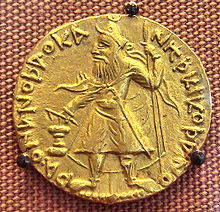Kanishka I (Greco-Bactrian: ΚΑΝΗϷΚΕ Kanēške; Kharosthi: 𐨐𐨞𐨁𐨮𐨿𐨐 Ka-ṇi-ṣka, Kaṇiṣka;[1] Brahmi: ![]()
![]()
![]() Kā-ṇi-ṣka), or Kanishka the Great, an emperor of the Kushan dynasty in the second century (c. 127–150 CE),[2] is famous for his military, political, and spiritual achievements. A descendant of Kujula Kadphises, founder of the Kushan empire, Kanishka came to rule an empire in Bactria extending to Pataliputra on the Gangetic plain. The main capital of his empire was located at Puruṣapura in Gandhara, with another major capital at Kapisa.
Kā-ṇi-ṣka), or Kanishka the Great, an emperor of the Kushan dynasty in the second century (c. 127–150 CE),[2] is famous for his military, political, and spiritual achievements. A descendant of Kujula Kadphises, founder of the Kushan empire, Kanishka came to rule an empire in Bactria extending to Pataliputra on the Gangetic plain. The main capital of his empire was located at Puruṣapura in Gandhara, with another major capital at Kapisa.
His conquests and patronage of Buddhism played an important role in the development of the Silk Road, and in the transmission of Mahayana Buddhism from Gandhara across the Karakoram range to China. Around 127 CE, he replaced Greek by Bactrian as the official language of administration in the empire.[3]
Earlier scholars believed that Kanishka ascended the Kushan throne in 78 CE, and that this date was used as the beginning of the Saka calendar era. However, historians no longer regard this date as that of Kanishka's accession. Falk estimates that Kanishka came to the throne in 127 CE.[4]















0 comments:
Post a Comment